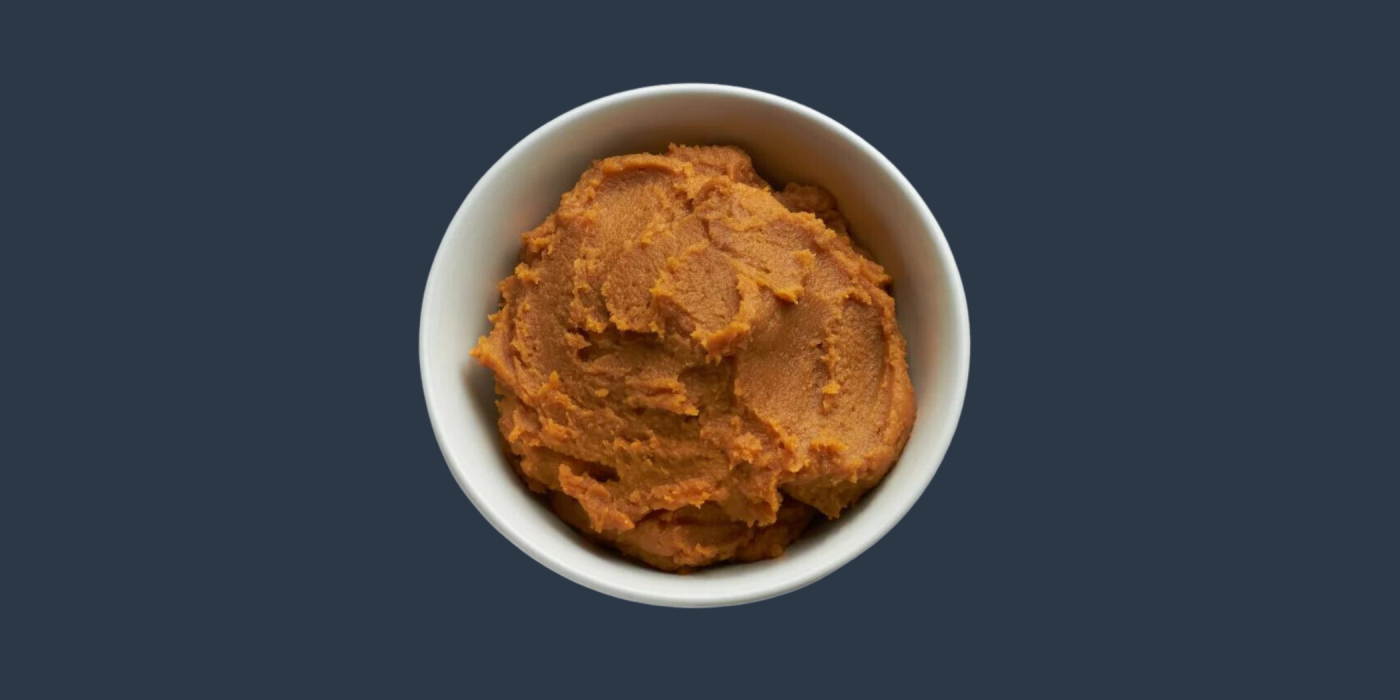Miso Demystified: Nutritional Insights, Health Gains, and a Homemade Recipe

Deep-rooted in the culinary heritage of Japan, miso is an unmissable ingredient that has been gracing the dining tables of Japanese households for centuries. With its rich, savoury flavour profile and nutritious content, miso not only delivers a unique gastronomic experience but also brings an array of health benefits.
An Overview of Miso
Miso, a traditional Japanese seasoning, is a fermented paste made from soybeans, salt, and a type of fungus known as koji. Depending on the variant, other grains such as rice or barley may also be included. The paste is highly versatile, offering a distinctive umami flavour that enhances a variety of dishes, the most famous of which is miso soup.
The History and Origin of Miso
Miso's history traces back to the Neolithic era in China, from where it eventually made its way to Japan around the 7th century AD. The Japanese refined the fermentation process, producing various types of miso that differ in flavour, colour, and texture. Today, miso holds a prominent place in Japanese cuisine and is gaining recognition worldwide for its flavour and health benefits.
What Lies Ahead in the Article
In this comprehensive guide, we will delve into the intricate world of miso. We'll explore the nutrient profile of miso, including its vitamins, minerals, and probiotic content. The health benefits associated with regular consumption of miso will be discussed, along with guidance on the recommended daily intake. We'll also share a simple recipe for making miso soup at home and address some frequently asked questions about this remarkable ingredient. So, let's embark on this flavoursome journey!
Unveiling Miso
Miso is a traditional Japanese seasoning, renowned for its unique flavour and health-enhancing properties. This flavourful paste, used in a myriad of dishes, is crafted from fermented soybeans, salt, and a type of fungus known as koji.
What Exactly is Miso?
Miso is best described as a thick paste, often with a texture comparable to peanut butter. It presents a complex taste profile, being salty, slightly sweet, and rich in umami, the 'fifth taste' that imparts a satisfying depth to many dishes. The colour of miso can range from white to dark brown, typically hinting at its flavour intensity: lighter miso tends to be sweeter and less salty than its darker counterparts.
While soybeans are the most common base for miso, it's not uncommon to find variants using other grains or legumes. Barley (mugi miso), rice (genmai miso), and chickpeas are all used in different types of miso, each lending a distinctive taste and nutritional profile to the finished product.
The Fermentation Process of Miso
The magic of miso begins with its fermentation process, a culinary alchemy that transforms simple ingredients into a powerhouse of flavour and nutrition. The process starts with soybeans, which are soaked, cooked, and then combined with salt and koji. Koji, a mold scientifically known as Aspergillus oryzae, is essential for kickstarting the fermentation process.
The mixture is left to ferment and mature over weeks, months, or even years. During this time, the enzymes from the koji break down the carbohydrates and proteins in the soybeans into easily digestible components, including an array of amino acids that contribute to miso's umami flavour.
In essence, miso represents a remarkable harmony of taste and health, brought to life through the time-honoured art of fermentation.
Nutrient Profile of Miso
Miso's unique flavour and health benefits derive in large part from its rich nutritional profile. This fermented paste boasts a balanced composition of carbohydrates, protein, fat, and fibre, in addition to a selection of essential vitamins and minerals.
Nutrients in Miso
Miso is primarily composed of carbohydrates, constituting around 35% to 60% of its dry weight, depending on the type. Proteins make up about 12% of miso, including essential amino acids that your body requires for healthy function. Fats are present in a smaller amount, with a concentration of about 6%, while dietary fibre contributes around 5% to 10% of miso's composition.
Vitamins in Miso
When it comes to vitamins, miso is an excellent source of several B vitamins. These include vitamin B2 (riboflavin), vitamin B6, and vitamin B9 (folic acid). These vitamins play key roles in energy metabolism, brain function, and red blood cell production.
Minerals in Miso
Miso is a treasure trove of essential minerals. It's particularly high in sodium, due to its fermentation process, but also contains appreciable amounts of potassium, calcium, magnesium, phosphorus, and iron. These minerals are crucial for a variety of bodily functions, including maintaining fluid balance, bone health, and oxygen transport.
Probiotic Content of Miso
Last but certainly not least, miso is a natural source of probiotics, thanks to its fermentation. This process encourages the growth of beneficial bacteria and yeast strains, such as Aspergillus oryzae and Lactobacillus species, contributing to improved gut health and digestion.
Health Benefits of Miso
Miso, beyond being a savoury addition to many dishes, has a variety of health benefits, thanks to its rich nutrient profile and fermentation process.
Gut Health Improvement
Miso is a fermented food, which means it is a good source of probiotics or beneficial bacteria. These probiotics can help to balance the gut flora, improving digestion and nutrient absorption. Furthermore, a healthier gut can also positively influence overall health and well-being.
Immune System Support
The probiotics found in miso do more than just support gut health. They also play a significant role in maintaining a robust immune system. A healthy balance of gut flora has been linked to enhanced immunity, with studies suggesting that it can help protect against infections and illnesses.
Potential Heart Health Benefits
Miso, despite its high sodium content, has been associated with heart health benefits. Research indicates that the sodium in miso does not affect cardiovascular health in the same way that sodium from other sources might. Some studies suggest that miso consumption might be linked to lower risks of heart disease, although more research is needed in this area.
Antioxidant Properties
Miso is rich in antioxidants, which are compounds that help protect your body from damage by free radicals, potentially reducing the risk of chronic diseases like cancer and heart disease.
Possible Benefits for Bone Health
Lastly, miso contains a good amount of both calcium and vitamin K, nutrients that are essential for bone health. Regular intake of these nutrients can contribute to maintaining strong and healthy bones, potentially lowering the risk of osteoporosis.
Recommended Daily Amount of Miso
Determining an appropriate daily intake of miso can be a balancing act, taking into account its high sodium content alongside its many nutritional benefits.
Miso Intake for Adults and Children
For adults, it is generally safe to consume 1-2 tablespoons (18-36 grams) of miso per day. This allows you to enjoy the benefits of miso while avoiding excessive sodium intake. Children, with their lower daily sodium requirements, should consume a smaller amount. As with all new foods, it's best to introduce miso into a child's diet gradually and observe for any adverse reactions.
Considerations for Special Populations
For individuals with certain health conditions, such as high blood pressure or kidney disease, it might be necessary to limit miso consumption due to its high sodium content. Those on a low-sodium diet should consult with a healthcare provider to assess whether and how much miso can be incorporated into their diet.
Balancing the Benefits and Sodium Content
Miso offers a myriad of health benefits including probiotics, essential minerals, and vitamins. However, its high sodium content necessitates mindful consumption. To balance these factors, consider using miso as a flavour-enhancer in your dishes, allowing you to reduce or eliminate additional salt. You can also pair miso-based dishes with low-sodium foods to balance your overall daily sodium intake.
Incorporating Miso into a Balanced Diet
Miso can be incorporated into a balanced diet in a variety of ways. Its rich, umami flavour lends itself well to soups, marinades, dressings, and stir-fries. Start by adding small amounts to your dishes and adjust to taste. By using miso thoughtfully, you can enrich your diet both in terms of flavour and nutrition.
How to Make Miso Soup at Home
Miso soup is a versatile dish that's as nourishing as it is straightforward to prepare. It's a heartening example of how simple ingredients can come together to create a symphony of flavours. With a few key components and a dash of creativity, you can make your own miso soup at home.
Introduction to the Simplicity and Versatility of Making Miso Soup
Miso soup embodies the principle of simplicity in Japanese cuisine. Its base consists of just two main ingredients: miso paste and dashi (a type of Japanese stock). From there, you can enhance the soup with a variety of ingredients based on your personal preferences, seasonal availability, or dietary requirements.
Step-by-step Guide to Preparing Your Own Miso Soup
-
Prepare the Dashi: Bring a pot of water to boil and add kombu (a type of seaweed). After about 10 minutes, remove the kombu and add bonito flakes. Once it boils again, strain the mixture and your dashi is ready.
-
Add the Miso Paste: Place a few tablespoons of miso paste into a separate bowl. Add a bit of dashi and mix until the miso paste is fully dissolved. Then, add this mixture back into the pot of dashi.
-
Add Additional Ingredients: Finally, add your choice of vegetables, tofu, or seafood, and simmer until they're cooked. Remember to add delicate ingredients like spring onions just before turning off the heat.
Tips for Storing and Using Homemade Miso
Your homemade miso soup can be stored in the refrigerator for up to a week. Remember to store it in an airtight container to preserve its freshness. Also, miso paste, once opened, can last for up to a year in the fridge. It's a versatile ingredient that can also be used in dressings, marinades, and other dishes.
Summing Up
Nutritional Profile of Miso
To recap, miso is a treasure trove of essential nutrients, housing an array of vitamins, notably B vitamins, and a rich mineral content including sodium, potassium, calcium, magnesium, phosphorus, and iron. It's worth noting the protein and fibre contributions, which play an essential role in maintaining a healthy diet. Not to forget, miso's probiotic content, beneficial for our gut health and overall wellbeing.
Health Benefits of Miso
From a health perspective, miso holds a promising stance. Its potential health benefits range from promoting gut health, boosting the immune system, contributing to heart health, offering antioxidant properties, and even potential benefits for bone health.
Daily Recommendations and Miso Soup Recipe
We've also discussed the recommended daily amount of miso, which allows you to reap its benefits while avoiding the potential pitfalls of its high sodium content. Our easy-to-follow recipe for miso soup provides a delicious way to introduce this potent foodstuff into your diet.
Incorporating Miso into Your Diet
Miso is more than just a base for soup — its complex umami flavour makes it an adaptable addition to a variety of dishes, from marinades to dips and salad dressings.
If you haven't explored the world of miso yet, it's high time you did. Its impressive nutritional profile, combined with its unique taste, makes it a valuable addition to any kitchen. Remember, the best diet is a varied one, and miso offers another string to your culinary bow. Try it, experiment with it, and enjoy the richness it brings to your meals!
Frequently Asked Questions
In this section, we'll answer some common queries about miso. We'll explore different types of miso, its suitability for a low-sodium diet, how to store it, and more.
What are the different types of miso?
There are several types of miso, but the most common are white (shiro), red (aka), and mixed (awase). White miso is mild and sweet, while red miso has a deeper, more robust flavour. Mixed miso is a blend of the two, offering a balanced taste.
Can you consume miso if you're on a low-sodium diet?
Miso does contain a high amount of sodium, so it should be consumed in moderation if you're on a low-sodium diet. However, because the flavour of miso is so rich, you often need less of it than you would of salt, so it can be a beneficial substitute in some recipes.
Can you eat miso paste raw?
Yes, miso paste can be eaten raw, and many people enjoy the rich, savoury flavour it adds to a variety of dishes. Adding it to hot dishes towards the end of cooking can help preserve its probiotic benefits.
How do you store miso?
Miso should be stored in an airtight container in the refrigerator. It's a fermented product, so it will keep for a long time without spoiling.
How long does homemade miso soup last?
Homemade miso soup can be stored in the refrigerator for up to a week. It's best to add the miso paste to the soup just before serving to maintain its flavour and health benefits.
Concluding Remarks
Miso, a culinary gem with a rich heritage and intriguing fermentation process, offers a wealth of nutrients, vitamins, and minerals, as well as probiotic benefits. The simple yet flavoursome miso soup provides a straightforward way to integrate miso into your regular diet, allowing you to appreciate the umami-rich depth it can bring to dishes.
While the high sodium content of miso necessitates mindful consumption, particularly for those on a low-sodium diet, its potential health benefits and unique savouriness make it a worthwhile addition to a balanced diet. Be it for its gut health benefits, potential immune support, or simply for the sheer love of its taste, miso has a place in every adventurous kitchen.
Remember, as with any dietary change, listen to your body, and consult with a healthcare professional if you have specific dietary needs or health concerns. Enjoy the journey into the world of miso!
Related to this article are the following:
- The Ultimate Guide to Kimchi: Nutrition, Health Benefits and a Classic Recipe
- Unlocking Sauerkraut: A Comprehensive Guide to Its Nutrition, Health Benefits, and DIY Recipe
- Natto Knowledge: Nutrition, Health Benefits, and a DIY Recipe Guide
- Tempeh Treasure: Health Benefits, Nutritional Profile, and a Simple Recipe
- The Ultimate Kefir Guide: Nutrients, Health Benefits, Recipe and More
I do hope you have enjoyed this article and hope that you will subscribe to my newsletter so you can get the latest information about all things naturally relaxing.
Stay in touch, join the Naturally Relaxing Newsletter
Newsletter Signup
Post Your Comments
or post as a guest
Be the first to comment.
Latest articles in Food

Hot Cross Buns This Easter: A Timeless Tradition of Baking and Sharing

Chocolate Krispie Cakes for Easter: A Simple, Festive Treat for All

2023 Christmas Culinary Delights: Recipes for the Ultimate Festive Feast

Embrace Autumn with the Best Pumpkin Spice Recipes in the UK

Turning Pumpkin Carvings into Pumpkin Pie: A British Culinary Tradition






